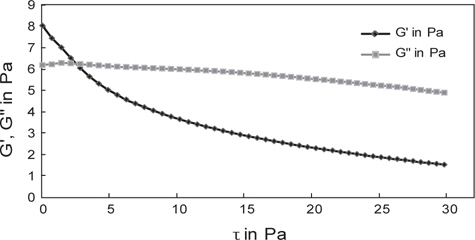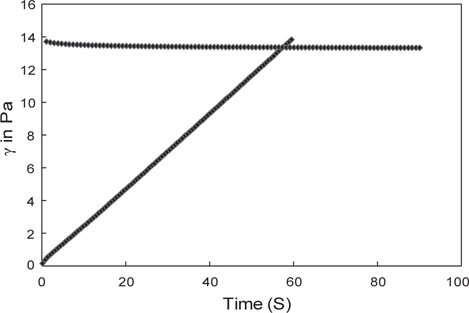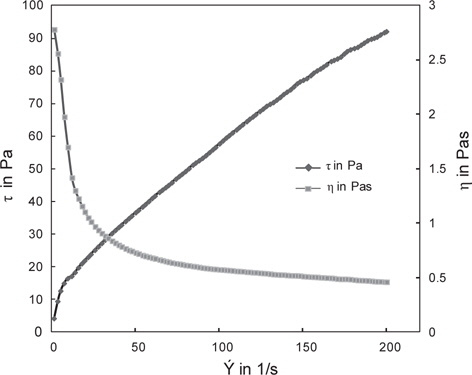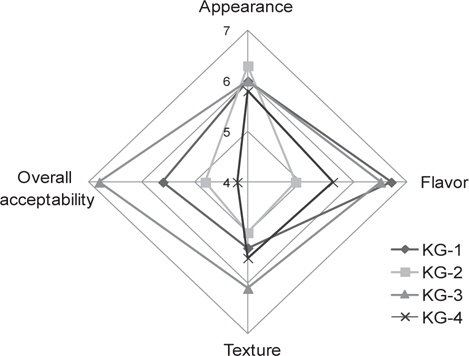



Instant krill gruel was produced using peeled Antarctic krill
남극 크릴(
크릴은 단백질과 불포화지방산 함량이 높은 것으로 알려져 있다. 크릴의 단백질은 FAO/WHO/UNU에서 요구하는 성인에게 필요한 필수아미노산 9종을 함유하고 있으며(Nicol et al., 2000; Young and pellet, 1991), 우유 단백질인 casein과 소화율이 유사하여 영양학적으로도 우수한 것으로 알려져 있다(Gigliotti et al., 2008). 크릴의 불포화지방산 중에서 DHA (16.6-36.5%)와 EPA (11.1-24.8%)가 다량 함유되어 있다(Virtue, 1995).
그러나 크릴은 인체에 위해성이 알려진 불소를 다량함유하고 있다(Ishiguro et al., 1993; Vani and Reddy, 2000; Lu et al., 2000; Spittle, 2009). 크릴은 536-2,400 mg/kg 농도의 불소를 함유하고 있는데, 그 중에서 육에는 4.5-570 mg/kg, 껍데기에는 1,800-4,260 mg/kg로 다량의 불소를 함유하고 있다(Soevik and Breakkan, 1979; Adelung et al., 1987; Park et al., 1988; Kim et al., 1990a; Zhang et al., 1993; Sands et al., 1998; Moren et al., 2007; Yoshitomi et al., 2007; Xie et al., 2012; Jung et al., 2013).
이와 같이 크릴은 많은 양의 불소를 함유하기 때문에 식품으로의 이용에 제한이 많아 사료나 낚시 미끼로 주로 사용되고 있다(Kubitza and Lovshin, 1997; Kolkovski et al., 2000).
크릴의 이용에 관한 연구를 보면, krill protein concentration(KPC) 제조와 크릴 가공부산물을 이용한 carotenoprotein과 chitosan의 제조법 등이 알려져 있으며(Kuwano and Mitamura, 1977; Oehlenschlager and Schreiber, 1981; Kim et al., 1990b; Kim et al., 2000), 식품으로는 크릴 간장, 크릴 된장, 크릴즙이 첨가된 순두부 분말 및 크릴 오일 등이 보고되고 있다(Han et al., 1979; Lee et al., 1984; Kim et al., 2009; Bunea et al., 2004; Maki et al., 2009). 그러나 이들 크릴 가공품에 불소가 어느 정도 함유되는지는 명확하게 알려지지 않고 있다.
본 연구에서는 자원이 풍부하고 영양학적으로 우수한 미래 식량자원인 크릴의 활용도를 높이기 위한 목적으로 불소 함량이 낮은 크릴육을 이용한 인스턴트 크릴 죽을 제조하여 영양성분, 색도, 불소함량, 물성 및 관능 특성 등을 평가하였다.
실험에 사용된 크릴육은 2010년 3월부터 8월까지 남극해에서 어획하여 선상에서 탈각 후 냉동상태로 보관한 것을 2011년 4월에 ㈜동원산업(Busan, KOREA)으로부터 제공받아 -25℃ 냉동고에 저장하여 두고 실험에 사용하였다. 크릴죽 제조에 사용된 찹쌀, 야채류와 소금은 국내산으로 메가마트(부산)에서 구입하여 사용하였다. 엑기스류는 이에스식품원료(Gunpo, Korea)에서 구입하여 사용하였다. 실험에 사용된 시약은 모두 일급 이상을 사용하였다.
크릴육 100 g을 물 1,000 mL가 담긴 용기에 넣고 1분간 유리막대로 저어준 후 20 mesh 체에 받쳐 물기를 제거하였다. 같은 방법으로 2회 더 수세하고 물기를 제거한 후 죽 제조에 사용하였다. 이때 수분함량은 85±1%였다. 그리고, 당근, 양파, 감자는 씻어서 껍질을 제거한 후 야채 다지기(GF-80, GEFU, Eslohe, Germany)로 dice 형태로 처리하였다. 건조표고버섯은 물에 1시간 불린 후 물기를 제거하고 야채 다지기로 처리하였다. 쌀은 불리는 과정 없이 그대로 사용하였다. 크릴죽의 제조를 위한 배합비율은 Table 1과 같다. 크릴죽의 제조방법은 수세 크릴육과 찹쌀, 야채류, 엑기스류 및 소금을 플라스틱용기(1,000 mL, polypropylene)에 담아 혼합 후 autoclave (MLS-3020, Sanyo Electric Co., Ltd., Moriguchi, Japan)에 넣고 121℃에서 15분 동안 가열하였다. 이때 autoclave 내부 온도가 100℃ 이상에서 머문 총 시간은 70분이었다. 조리 후 밀봉한 용기는 찹쌀이 퍼지는 것을 방지하기 위해 흐르는 물에서 20℃가 될 때까지 냉각한 후 분석 및 관능평가에 사용하였다.
[Table 1.] Formulas for preparation of instant krill Euphausia superba gruel
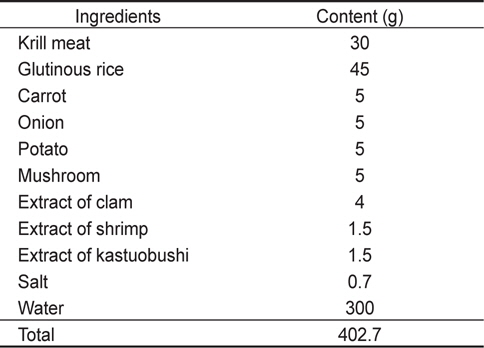
Formulas for preparation of instant krill Euphausia superba gruel
영양성분은 수분, 탄수화물, 당류, 단백질, 지방, 포화지방, 트랜스지방, 콜레스테롤에 대하여 측정하였다. 모든 실험법은 Horwitz (2005)에 따라 실시하였다. 수분은 105℃ dry oven (OF-22GW(151L), JEIO TECH, KOREA)을 이용하여 측정하였고, 당류는 HPLC (HPLC 1100 series, Agilent, USA)로 측정하였다. 단백질 함량은 단백질 분해장치(Foss tecator digestor auto,FOSS, USA)와 자동질소정량분석기(Kjeltec auto 2300, FOSS, USA)를 이용하여 측정하였다. 지방 함량은 Rose-Gottlieb method (RG method)으로 측정하였고, Gas chromatography (Agilent 7890 GC, Agilent, USA)를 이용하여 포화지방, 트랜스지방, 콜레스테롤을 산출하였다. 나트륨은 microwave (MARS5, CEM, USA)를 이용하여 분해하고 atomic absorption spectrometry (AAnalyst 700, Perkin elmer, USA)로 측정하였다.
그리고, pH는 크릴 죽을 주스 믹서(HR2860, Ya Horng, Dong Guan Cuangdong, China)로 30초간 균질 후 증류수를 가하여 10% 용액으로 한 후 pH meter (model 15, Fisher Scientific, Waltham, USA)로 측정하였다.
지방산 분석은 Folch et al. (1957)의 방법에 따라 chloroform: methanol (2:1,v/v) 용액을 이용하여 지방을 추출한 후 AOCS (1998) 방법에 따라 methylation하였다. 즉, 추출한 지방 100 mg을 toluene 5 mL에 녹이고, BF3-methanol 3 mL가하여 75℃에서 30분간 가열하였다. 가열 후 hexane 3 mL와 10% NaCl 1 mL를 첨가하여 지방산 유도체를 추출하여 지방산 분석용 시료로 사용하였다. 지방산의 분석은 Gas chromatography (5890 Series II GC system, Hewlett Packard, USA); column, DB-Wax capillary column (30 m length X 0.250 mm internal diameter, 0.25 μm of film); carrier gas, He; detector, FID; column temperature, 130℃ to 240℃ at a rate of 4℃/min) 이용하였고, 표준용액은 standard fatty acid methyl ester mixture (Supleco, USA)를 사용하였다.
총 아미노산은 Chen et al. (2009)의 방법에 따라 분석하였다. 시료 0.8 g에 6 N HCl을 10 mL를 가하여 감압 밀봉한 후, 110℃의 dry oven (OF-22GW(151L), JEIO TECH, KOREA)에서 22시간 동안 산 가수분해 시켰다. 가수분해액은glass filter로 여과하고, 여과액은 55℃ 에서 감압 농축하였다. 그 후 sodium citrate buffer (pH2.2) 10 mL에 녹여서 0.45 μm membrane filter (Tyoko Roshi Kaisha, Japan)로 여과하여 amino acid analyzer (Biochrom-30, Amersham, U. K.)로 분석하였다.
불소는 ASTM(2002)과 Horwitz (2005)의 방법을 수정한 Jung et al. (2013)의 방법으로 분석하였다. 연소장치(1108 oxygen combustion bomb, Parr, Moline, Illinois, USA) 에 1 N NaOH 10 mL와 동결 건조 시료 0.5 g을 각각 따로 넣고, 밀폐하였다. 그 후 산소를 주입(30 atm)하고 점화(2901 ignition unit, Parr, Moline, Illinois, USA)시켜 5분간 완전 연소시켰다. 연소 후 기화된 불소는 연소장치를 흔들어 1 N NaOH에 용해시키고, 연소장치의 압력을 대기압으로 하였다. 그 후 연소장치를 개방하여 NaOH 용액을 황산:물(2:3, v/v) 용액 150 mL가 들어있는 증류 플라스크(500 mL)에 옮겼다. 증류플라스크는 냉각관이 달린 증류장치에 연결하고 시료 주입구를 통해 물을 보충하며 170℃에서 3시간 증류하였다. 증류액은 물을 가하여 500 mL로 하였다. 증류액 25 mL에 5% alfusone (La+ALC+Buffer, Dojindo, Kumamoto, Japan)용액 5 mL와 acetone 10 mL를 가하여 50 mL로 하고 1 hr 실온에서 방치하였다. 이를 UV-Spectrophotometer (UV-1800, Shimadzu, Kyoto, Japan)를 사용하여 620 nm에서 흡광도를 측정하여 불소를 정량 하였다. 불소의 정량은 fluoride ion standard solution (F- 1,003 mg/L, Kanto Chemical, Tokyo, Japan)을 이용한 검량선으로 구하였다. 불소의 회수율은 103.33±1.77%이었다.
크릴죽의 색도는 크릴죽을 쥬스 믹서(HR2860, Ya Horng, Dong Guan Cuangdong, China)로 균질 후 석영 cell에 담아 색차계 reflectance tintometer (RT series, Lovibond, Amesbury, U.K)로 Hunter’s color를 측정하였다. Hunter’s color는 L, a, b값으로 구성되어 있다. L값은 명도를 나타내는 값으로 최대값 100으로 갈수록 밝아지고, 최소값 0으로 갈수록 어두워진다. 색도의 a값이 (+)이면 붉은색이고, (-)값이면 녹색을 띤다. 또한 b값이 (+)이면 황색을 띠고, (-)이면 청색을 띤다.
점탄성 측정은 Rasteiro and Antunes (2005)의 방법에 따라 측정하였다. 크릴 죽 시료를 20 mesh체에 걸러 그 액의 물성을 rheometer (Rheostress1, HAAKE, Vreden, Germany)와 Sencer (Z20DINTI, HAAKE, Vreden, Germany)로 측정하였다.
관능검사는 Meilgaard et al. (1991)의 방법을 참고하여 부경대학교 식품공학과 학부생과 대학원생 10명을 대상으로 실시하였다. 20℃로 맞춘 크릴죽으로 오후 3시에서 4시 사이에 관능검사를 실시하였다. 검사 항목은 appearance, flavor, texture, overall acceptability에 대해 좋아하는 정도를 9점 척도로 검사하였다.
크릴죽 100 g당의 영양학적 특성은 Table 2에 나타내었다. 크릴죽의 탄수화물은 100에서 수분, 단백질, 지방 및 회분을 뺀 값으로 결정하였다. 열량은 크릴죽 100 g 중 단백질, 지방 및 탄수화물에 단백질 4, 지방 9, 탄수화물 4의 계수를 곱하여 각각의 열량을 킬로칼로리(kcal)단위로 산출하고 그 총계로 나타내었다. 크릴죽은 51.46 kcal의 열량을 나타내었다. 총 탄수화물의 함량은 10.3 g으로 성인 일일 영양소 기준치 3%에 해당하였고, 단백질은 2.34 g으로 영양소 기준치 4%에 해당하였으며, 지방함량은 0.1 g으로 미미한 수준이었다. 포화지방산은 0.02 g이었고, 콜레스테롤은 3.48 mg으로 영양소 기준치 1%에 해당하는 콜레스테롤 함량을 나타내었다. 크릴의 콜레스테롤 함량은 66.1 mg/100 g으로 보고되고 있으며(Tou et al., 2007), 크릴죽의 콜레스테롤은 크릴에 기인하는 것으로 여겨진다. 나트륨은 112.02 mg으로 일일 영양소 기준치 6%에 해당하는 함량을 보였다. 크릴죽의 수분함량은 86.07%이고, 10% 용액에서 pH는 6.65로 측정되었다. 크릴죽의 pH는 일반적인 죽의 pH 6.5-7.1과 비슷한 결과를 보였다(Shin et al., 2008; Kim et al., 2010). 그리고 트랜스 지방은 검출되지 않았다.
[Table 2.] Nutrient composition of instant krill Euphausia superba gruel
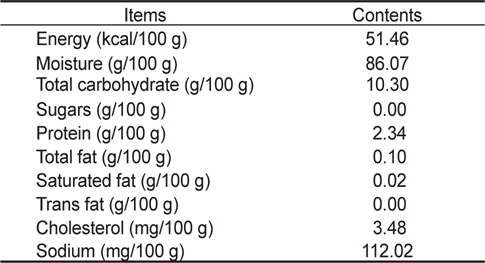
Nutrient composition of instant krill Euphausia superba gruel
크릴죽의 지방산 조성은 Table 3에 나타내었다. 전체 지방산 조성 중 포화지방산은 27.7%를 차지하였고, 불포화지방산은 72.3%를 차지하였다. 그 중에서도 n-3지방산 조성이 6.0%이고, n-6지방산이 3.4%, n-9지방산이 1.0%이었다. n-3 지방산에서 EPA (C20:5)가 3.1%이고, DHA (C22:6)는 2.1% 함유되어 있었다. 크릴죽의 주요 지방산은 oleic acid (C18:1)가 30.9%로 가장 높았고, 다음으로 linoleic acid (C18:2)가 28.6%, palmitic acid (C16:0)가 20.9%이었다. 크릴의 지방산 조성에 관한 보고를 보면, 불포화지방산이 48.6%-50.8%를 차지하고, 지방산 중에서는 palmitic acid가 32%로 가장 높고, 다음으로 oleic acid가 19%, EPA 9.7-36.5%, DHA 4.6-24.8% 순으로 높다고 알려져 있다(Virtue et al., 1995; Cripps et al., 1999). 그리고 Cho et al. (1999)의 연구에 의하면 크릴의 지방산 중에서 palmitic acid가 19.95%, EPA가 16.14%, 그리고 DHA가 14.09%로 나타났다. 또한 Yoshitomi and Nagano (2012)의 연구에서 크릴의 지방산 조성은 palmitic acid가 15.6%, oleic acid가 16.5%로 함유한다고 보고하고 있다. 크릴죽과 크릴의 지방산 조성을 비교하여 보면 불포화지방산의 함량이 높고, 그 중에서 linoleic acid의 함량이 높았고 EPA와 DHA의 함량은 낮게 측정되었다. 이러한 결과는 죽에 첨가된 다른 식물성 부재료의 영향으로 생각된다.
[Table 3.] Fatty acid composition of instant krill Euphausia superba gruel
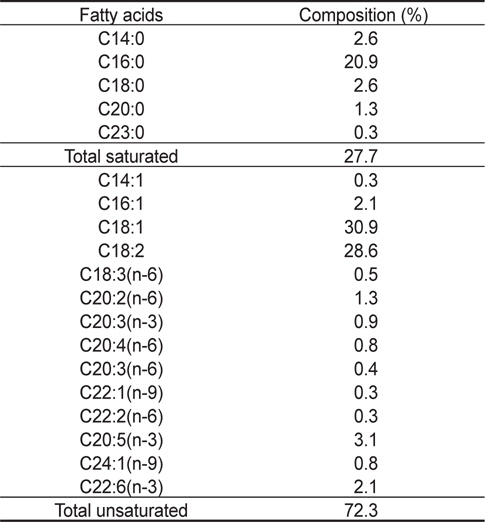
Fatty acid composition of instant krill Euphausia superba gruel
크릴죽의 아미노산 조성에 대한 결과는 Table 4에 나타내었다. 크릴죽의 총 아미노산 함량은 2,132.7 mg/100 g이었고, 주요 아미노산으로는 glutamic acid (18.1%), aspartic acid (10.8%), leucine (8.0%), alanine (7.8%), arginine (7.1%) 등이 었다. 크릴죽에는 필수아미노산 9종이 모두 함유되어 있고 그 양이 전체 아미노산 함량의 38.3%를 차지하였다. Chen et al. (2009)과 Gigliotti et al. (2008)의 연구에 따르면 크릴단백질에 가장 함량이 높은 아미노산은 glutamic acid로 116.7 mg/g 이고, 그 다음으로 aspartic acid이 106.3 mg/g이었다. Mohr and Saether (1987)의 연구에서도 glutamic acid와 aspartic acid, glycine, alanine, lysine, leucine의 함량이 높게 나타났다. 이 결과는 크릴죽의 아미노산 조성비의 결과와 비슷하였다.
[Table 4.] Total amino acid composition of instant krill Euphausia superba gruel
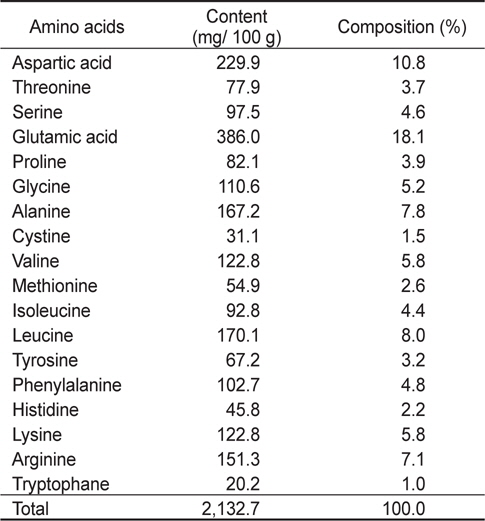
Total amino acid composition of instant krill Euphausia superba gruel
크릴죽의 불소 함량은 Table 5에 나타내었다. 크릴죽의 불소 함량는 3.07±0.20 mg/kg으로 나타났다. 크릴에는 불소함량이 높아 식용으로 사용되는데 제약이 따르고 있다. 크릴은 536-2,400 mg/kg 농도의 불소를 함유하고 있고, 껍질을 제거한 muscle에는 4.5-570 mg/kg 농도의 불소를 함유하고 있다(Soevik and Breakkan, 1979; Adelung et al., 1987; Sands et al., 1998; Moren et al., 2007; Yoshitomi et al., 2007; Xie et al., 2012). FDA에 따르면 식품에 사용하는 크릴의 불소함량 권고 기준을 100 mg/kg 이하로 하고 있다(FDA, 2012). 크릴 죽 제품은 불소 함량이 3.07±0.20 mg/kg으로 낮았으며, FDA의 식품의 불소함량 권고 기준 이하였다.
[Table 5.] Content of fluoride in instant krill Euphausia superba gruel

Content of fluoride in instant krill Euphausia superba gruel
크릴죽의 색도는 Hunter lab color scale에 따라 Table 6에 나타내었다. 크릴죽의 색도는 L값이 46.32±0.57, a값이 +0.88±0.30, b값이 +13.23±0.43으로 나타났다. 크릴죽은 색도는 엑기스류의 진한 색상의 영향으로 L값이 낮게 나타났고 b값이 높게 측정되었다.
[Table 6.] Hunter color value of instant krill Euphausia superba gruel

Hunter color value of instant krill Euphausia superba gruel
인스턴트 크릴죽의 점탄성 결과는 Fig. 1에 나타내었다. 55℃ 온도 조건에서 shear stress (τ)를 0부터 30까지 연속적으로 증가 시켰을 때 elasticity force (G")과 viscous force (G')의 변화를 관찰하였다. 시료의 탄성는 shear stress가 증가할수록 급격히 떨어지고, 점성은 서서히 감소하였다. Shear stress가 2.512 Pa 영역에서 시료의 파괴가 일어나며 그 보다 낮은 영역은 비파괴영역, 그 보다 높은 영역은 파괴영역으로 나타났다. 탄성력과 점성력이 교차하는 시점의 점탄성은 6.28 Pa로 측정되었다. 앞에서 측정한 비파괴영역의 shear stress (2.0 Pa)에서 온도(55℃)를 일정하게 유지하면서 시간에 따른 shear rate (γ)의 변화를 알아본 결과를 Fig. 2에 나타내었다. 60초 동안 일정한 stress를 주었을 때 크릴죽은 shear rate는 점점 증가하였다. 그다음 stress를 멈추고 90초 동안 shear rate의 변화를 관찰하였다. Shear rate는 13.89 Pa에서 13.39 Pa로 조금 감소하지만 처음의 상태로 회복되지는 않았다. 이는 인스턴트 크릴죽의 저장 안정성을 알아보기 위한 것으로 변형 후 recovery force가 약한 것을 알 수 있었다.
Shear rate (Ý)의 증가에 따른 shear stress (τ)와 viscosity (η)의 변화에 관한 결과는 Fig. 3에 나타내었다. Shear rate가 증가하면 shear stress도 함께 증가하였다. 반면 viscosity는 감소하였다. Shear rate 40 1/s 이후로 viscosity는 0.46-0.78 Pas의 범위에서 측정되었다. 죽의 점도는 수분 함량이 낮을수록 높아지고 쌀의 입자크기가 작아질수록 높아진다(Yang et al., 2007; Kim et al., 2010).
크릴죽의 관능평가 결과는 Fig. 4와 Table 7에 나타내었다. 최종 크릴죽 배합비 산출을 위한 선행실험으로 크릴육 함량, 쌀의 종류, 물 첨가량에 따른 관능을 비교하여 기초 배합비를 완성하였다. 크릴육은 30 g을 첨가하였을 때, 쌀은 찹쌀을 사용하였을 때, 물은 300 g을 첨가하였을 때 가장 좋은 기호도를 나타내었으며, 기초 배합비를 기준으로 최종 배합비율에 적용하였다. 크릴육 첨가량과 쌀 종류, 물 첨가량을 고정하고 첨가하는 추출물의 종류에 따른 관능평가를 실시하였다. 쇠고기 분말을 첨가한 시료(KG-1), 다시마 추출물을 첨가한 시료(KG-2), 가쓰오부시 추출물을 첨가한 시료(KG-3) 그리고 사골 추출물을 첨가한 시료(KG-4)로 기호도를 평가하였다. Appearance와 texture는 모든 시료에서 유의차가 없는 결과를 보였다. Flavor는 쇠고기 분말을 첨가한 KG-1과 가쓰오부시 엑기스를 첨가한 KG-3이 다른 시료와 비교하여 유의차 있게 기호도가 높게 나타났다. overall acceptability는 KG-3이 6.8점으로 유의차 있게 높은 기호도를 나타내었다. 전체적인 관능평가 항목에 대한 점수를 비교하여 가장 기호도가 높은 배합비는 KG-3이었다.
[Table 7.] Sensory properties of instant krill Euphausia superba gruel.

Sensory properties of instant krill Euphausia superba gruel.
Park et al. (2007)의 연구에서는 찹쌀, 찹쌀현미, 찹쌀흑미에 따른 관능평가 결과를 9점 척도로 나타내었으며, 찹쌀현미의 기호도가 가장 높게 나타났다. Cho and Kim (2009)는 새우분말의 함량에 따른 죽의 관능평가를 실시하였는데 새우분말 3%를 첨가한 죽의 기호도가 가장 높게 나타났다.
크릴을 식품으로의 이용도를 높이기 위해 크릴육을 이용한 인스턴트 크릴죽을 제조하고 그 영양성분과 물리적, 관능적 특성을 평가하였다. 크릴죽의 일반성분, 콜레스테롤, 열량, 색도, 아미노산 조성, 불소함량, 물성과 관능평가를 실시하였다. 크릴죽은 87%의 수분을 함유하고 있고, 열량은 100 g당 51 kcal이었다. 지방함량은 0.1%로 낮았으며, 지방산 조성에서 불포화지방산(oleic acid, linolenic acid)의 비중이 높았다. 아미노산의 함량은 2,132 mg/100 g이었고, glutamic acid, aspartic acid의 비중이 가장 높았다. 크릴죽의 불소 함량은 3.07 mg/kg으로 FDA 기준 이하였다. 크릴죽의 점탄성은 shear stress 2.51 Pa에서 6.25 Pa로 측정되었다. 관능평가 결과 가쯔오부시 추출물을 첨가한 크릴죽의 기호도가 가장 높게 나타났다.







